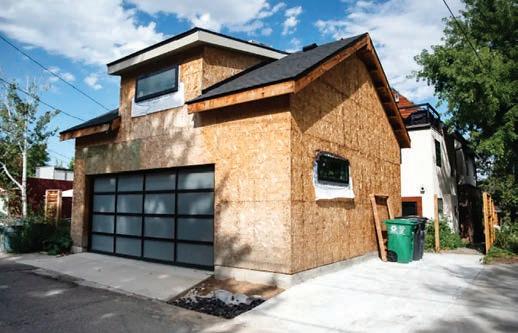
6 minute read
Requirements dramatically pared back in governor’s “land-use” bill
BY JESSE PAUL AND ELLIOTT WENZLER THE COLORADO SUN
Gov. Jared Polis and Democrats in the Colorado legislature signi cantly pared back their major land-use bill amid big questions about whether their signature a ordable housing initiative at the Capitol this year can get enough support to pass.
Colorado’s largest cities would no longer be required to let multifamily housing with up to six units be built in all residentially zoned areas under a major amendment made to Senate Bill 213. Instead, those cities — like Denver, Aurora, Boulder, Englewood, Colorado Springs, Fort Collins, Lakewood, Pueblo, ornton and Westminster — would only have to let duplexes, triplexes and fourplexes be built in 30% of their land area currently zoned for singlefamily homes, concentrated around train and high-frequency bus corridors where applicable.
e change, which came in midApril, shifts the legislation away from attempting to broadly increase housing density to a more limited approach linked to transit. Without the changes, it appeared the bill, which has received major opposition from cities and towns across the state, would lack enough support to clear its rst committee.
In all, there were 17 amendments made to the bill, totaling dozens of pages. One of the major changes reduces land-use requirements on resort communities, like Aspen and Vail.
e Senate Local Government and Housing Committee approved the overhauled measure on a 4-3 vote, with all of the Democrats on the panel voting “yes” and all of the Republicans voting “no.” It was unclear whether the measure would have enough votes to advance and the committee hearing was delayed for hours while amendments were nalized and negotiated.
Senate Majority Leader Dominick Moreno, a Commerce City Democrat and prime sponsor of the bill, warned that more changes were needed. “By no means does the work stop here,” he said.
Heading into a committee hearing, Sen. Dylan Roberts, an Avon Demo- crat, appeared to be the swing vote on the committee. He cast a reluctant “yes” vote. “I still have concerns with where the bill is,” he said, adding that there will be “a lot more to do” to get him to back the bill once it is debated on the Senate oor.
But two other Democrats on the committee — Sens. Julie Gonzales of Denver and Tony Exum of Colorado Springs — also expressed anxiety about the measure before voting to advance the legislation. e pair said more changes were needed.
“You will see more amendments coming,” Gonzales said.
An e ort by Sen. Barbara Kirkmeyer, a Brighton Republican on the committee to erase the measure and replace it with an alternative policy with no policy preemptions for local governments was rejected. “Senate bill 213, as it stands right now, … is never going to get us to a ordable housing,” she said. “All it’s going to do is preempt local governments.” e bill now heads to the Senate Appropriations Committee for approval before it can advance to the full Senate.
Under amendments, cities and towns would have to allow duplexes, triplexes and fourplexes to be built in a half-mile radius around rail stations and a quarter-mile around corridors with bus-rapid-transit or where a bus stops every 15 minutes.
If a municipality doesn’t want to allow building of two, three or four units next to certain transit stops they could opt to zone for that kind of housing in a di erent part of their city or town proportional to the area around a transit stop that would have been a ected. In doing so, however, the municipality would have to take steps to prevent people living in those areas from being displaced and would be encouraged to focus the zoning around walkable areas.
At a minimum, Colorado’s largest cities would have to allow duplexes, triplexes and fourplexes in 30% of the areas that are currently zoned for single-family homes. e requirement would also apply to large cities that don’t have train stops or bus rapid transit and bus routes with 15-minute frequencies, though they would be encouraged to prioritize zoned areas near transit. e cities that would be subject to the requirements include: Arvada, Aurora, Boulder, Brighton, Broomeld, Castle Pines, Castle Rock, Centennial, Cherry Hills Village, Columbine Valley, Commerce City, Denver, Edgewater, Englewood, Erie, Federal Heights, Glendale, Golden, Greenwood Village, Lafayette, Lakewood, Littleton, Lochbuie, Lone Tree, Longmont, Louisville, Northglenn, Parker, Sheridan, Superior, ornton, Westminster and Wheat Ridge. e amendments would also require that cities with bus rapid transit zone for an average housing density of 25 units an acre in at least 25% of the housing-eligible land without a half-mile of stops. e requirement would be the same for within a quarter-mile of corridors with frequent bus routes.
Additionally, the amendments remove a provision preventing cities from mandating that new duplexes, triplexes and fourplexes around train stations and along bus routes with a lot of frequency be accompanied by parking. Instead, the change allows municipalities to require that a half a parking spot be built alongside each new housing unit.
Outside of the Denver metro area, Greeley, Fort Collins, Loveland, Windsor, Colorado Springs, Fountain, Grand Junction and Pueblo would also fall under the mandates.
Cities with trains would have to zone for an average housing density of 40 units per acre in 50% of the housing-eligible land within a halfmile of stations.
Another amendment signi cantly changes the zoning shifts that would have been required of so-called rural resort job centers, including the Eagle River Valley near Vail and Roaring Fork Valley near Aspen.
Rural resort job centers are dened as municipalities that have a population of at least 1,000 and at least 1,200 jobs and are outside of a metropolitan planning organization, like the Denver Regional Council of Governments or the North Front Range Metropolitan Planning Organization. ey also have regional transit service with at least 20 trips per day. e legislation’s rural resort centers include: Avon, Breckenridge, Crested Butte, Dillon, Durango, Frisco, Glenwood Springs, Mountain Village, Silverthorne, Snowmass Village, Steamboat Springs, Telluride and Winter Park.
As originally written, the measure would have required adjacent towns in rural resort communities to work together to determine where to increase housing density and to identify bus corridors and work to increase residential and commercial development surrounding those
The Gallingers built their 550-squarefoot garage ADU to host friends and family during visits. Through an error in construction, the garage ended up being too tall, leading the couple to seek an individual zoning variance for the unit.

Under the amendments, rural resort communities would be required to choose at least ve options from a menu of 10 to 15 a ordability strategies included in the bill. Most of the resort communities already employ many of the listed strategies.
One of those options is letting property owners build accessorydwelling units, also known as ADUs or “granny ats.” Other strategies on the menu include restrictions on short-term rentals, like those listed on Airbnb or Vrbo, deed restrictions, expediting building permit review, and establishing a local revenue source to develop a ordable housing. One strategy would be for municipalities to waive permitting, infrastructure and utility fees for building a ordable housing developments.
“I think they sort of missed the boat in this rst draft and what should apply to us and what would work best for us,” said Eric Mamula, the mayor of Breckenridge and owner of Downstairs at Eric’s restaurant.
Mamula said his community’s top concerns with the introduced version of the legislation involved a lack of a ordability restrictions on new construction and no requirements that buyers and residents of new housing be part of the local workforce. ey also worried about the absence of permanence for a ordability and other regulations involving the newly mandated housing.
Last month Mamula said resort communities would be working with lawmakers and the governor to “make sure we are getting the point across that we need some protections for our smaller ski town communities.” e original version of the bill would have required rural resort centers to allow ADUs. Under the amended version, only municipalities in the rest of the state would be prevented from restricting them. Right now, ADUs may be built in many towns and cities only in certain zoning areas and the size of the units is governed by lot size. e bill would prohibit cities from requiring that new parking accompany any ADUs that are built. have enough money to close the gap at 10.1%. e scal year 2023-24 budget includes $485 million more in K-12 education funding than in the current year, which represents a $900 per-pupil increase. e budget calls for a 5.7% increase in base education spending to $8.9 billion and an 8.4% increase in average per-pupil spending to $10,404, Chalkbeat Colorado reports. ere’s no money in the budget, however, for buying down the budget stabilization factor — sometimes referred to as the negative factor
“I feel like we are being heard,” he said.
One amendment adopted at the behest of Sen. Sonya Jaquez Lewis, a Boulder County Democrat, adds unincorporated parts of counties to the list of places where ADUs can’t be prohibited.
Another change to the bill would allow municipalities to notify the state of their need for an extension or exemption from the requirements based on shortfalls in their water supply or infrastructure.
“My biggest regret (about the budget) is that we just were not able to close that gap fully,” she said.
Zenzinger said the JBC was trying to meet schools’ nancial needs without pricing students out of higher education. If the legislature were to allocate enough money to colleges and universities to cap tuition at 4% it wouldn’t have had any money left for new legislation and ongoing programs.
Total state funding for higher education in the budget was increased by $147 million to $1.4 billion.








